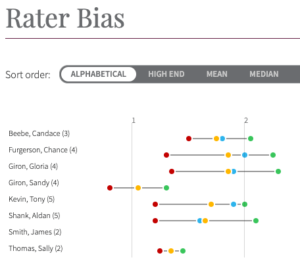Put Your Performance Data To Work
 Over time, ratings created across many performance reviews throughout the organization can provide real insight into a number of things. Having a manual or quasi-automated review system can be a barrier to being able to easily mine those data to assess what is happening in key areas of performance. Using an automated system that stores the data in a manner that allows for easy querying of those data provides a basis for generating reports and analyses easily and quickly. Having this capability allows organizations to zero in on performance issues and opportunities. Creating reports and analyses using historical performance review and 360 degree feedback data can allow you to draw inferences and conclusions about many performance related items which in turn can provide a basis for:
Over time, ratings created across many performance reviews throughout the organization can provide real insight into a number of things. Having a manual or quasi-automated review system can be a barrier to being able to easily mine those data to assess what is happening in key areas of performance. Using an automated system that stores the data in a manner that allows for easy querying of those data provides a basis for generating reports and analyses easily and quickly. Having this capability allows organizations to zero in on performance issues and opportunities. Creating reports and analyses using historical performance review and 360 degree feedback data can allow you to draw inferences and conclusions about many performance related items which in turn can provide a basis for:
- Identifying trends, both positive and negative, at various levels within the organization.
- Modifying existing or create new performance metrics at the employee, work unit, department, division and/or organization level.
- Zeroing in on specific work units or employees who are leading the way in terms of performance and those who are having problems that aren’t getting addressed.
- Creating training and development plans at various levels based on accumulated data and not intuition or limited data.
- Using the data to support coaching and discipline events and bring additional credibility to those discussions.
Some examples of information you might be interested in include:
- Competencies that appear to consistently receive low ratings across a department, division, or the organization as a whole. This type of information helps isolate where problems within specific performance variables might lie. It could point to a training and development gap that needs to be addressed, for example.
- A comparison of average overall ratings and average competency ratings for each manager. This can point to biases in how reviews are conducted, the quality of employees hired by each manager, unresolved training gaps, or other issues specific to the manager or the employees.
- A comparison of overall, competency, and/or goal level ratings across review periods. This query will help divulge trends and let you determine if progress is being made in improving performance across key performance areas. Various breakouts of these data can be helpful as well. For example, perhaps you would want to examine improvement or degradation in communication skills over the last 4 years by department.
- A ranking of overall ratings by employee across several review periods. This simple analysis can point out employees who are consistently top performers, those who are making progress, those who are struggling, and those who may have been allowed to continue employment beyond a reasonable time frame given their performance.
- A comparison of managers’ ratings from 360 degree survey by variable. This comparison can identify specific coaching or training needs for each manager.
These are just a few of the analyses that can result from having a wealth of performance related data stemming from performance reviews or 360 degree feedback surveys. There are many different ways to analyze your historical performance data that can be accommodated by a robust reporting tool contained within an automated performance management system.
Reviewsnap has what is believed to be the most extensive standardized and ad-hoc reporting tools available as part of its performance management solution. Give us a call to learn more about the benefits of using this type of reporting module.
